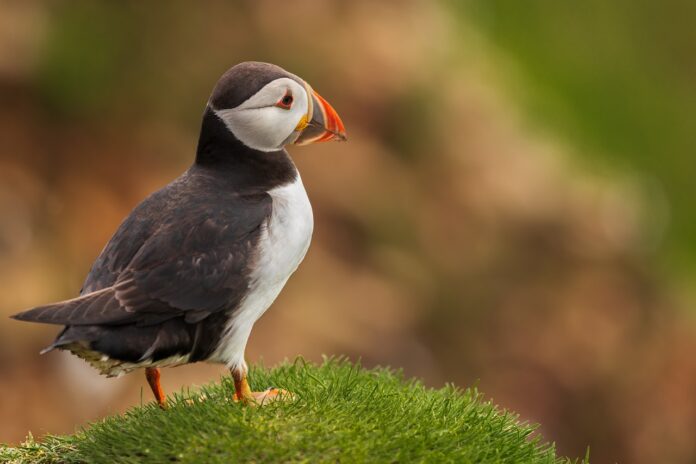In the northern regions, there are many unusual seabirds, all known for their bravery and endurance. However, among them, the puffin stands out for its unique and colorful appearance.
Description
Puffins live along the coasts of the Atlantic and Arctic Oceans. Their body shape and black-and-white coloring make them resemble small penguins. Their bodies are no more than 40 cm long, with a wingspan of up to 50 cm, and they weigh just about half a kilogram. Another distinctive feature of these birds is their short, triangular beak, which looks like a small hatchet. It is due to this beak that they got the name “puffin” (with emphasis on the first syllable).
During the breeding season, their beak changes color from orange to bright orange or even red, making them particularly attractive to the opposite sex.
The puffin’s head is dark, with occasional patches of gray. Due to their bright and unusual appearance, they are sometimes called “sea parrots.” Males and females look almost identical, with males being slightly larger.
In addition to their striking coloration, puffins can boast impressive speed. Though they look clumsy and even comical when running, resembling awkward little penguins, they are excellent swimmers and divers, capable of staying underwater for almost a minute without coming up for air. They do not fly high above the water’s surface, usually no more than 10 meters, but during flight, they can reach speeds exceeding 70 km/h. Their landings, however, are far from graceful, sometimes crashing directly into the water.
Habitat
These beautiful birds can be found in the Arctic and Atlantic Oceans. A large number also inhabit the northeastern part of North America. The largest puffin colony is located off the coast of Iceland, home to over 50% of the entire species population.
Puffins are solitary creatures and spend most of their time in the water. However, they come ashore in the spring. They live in burrows that they dig on hillsides or at the foot of cliffs.
Diet
Puffins primarily feed on fish, which they catch with ease in the water. Their favorites include capelin, herring, and sand eels. In addition to fish, they enjoy shrimp, sand eels, and mollusks. 
Due to their speed and agility in the water, they have no trouble catching their prey. Most of their catch consists of small fish no longer than 7 cm. When they catch a larger fish, they bring it ashore to eat. An adult puffin can eat around 40 fish per day, consuming about 200 g of food.
Reproduction
When breeding season arrives, puffins come ashore and wait for the ground to thaw a bit before they start digging burrows. They dig tunnels with their feet and beaks. Often, they restore old nests instead of digging new ones. If they find their old nest is gone, they either build a new one or move into an abandoned one.
Their breeding burrows are about 2 meters long. The male and female line the nest with grass and moss. After the female lays eggs, both parents take turns incubating them. They fiercely protect their offspring, not allowing chicks to leave the nest during the day because of predators. Parents let their chicks swim at night when it’s safer. The chicks stay in the water near the shore until dawn, after which they return to the burrow.
To start an independent life, a puffin chick must learn to swim, fly, and catch fish on its own. Once a puffin reaches three years of age, it begins looking for a mate to start its own family.
Interesting Facts About Puffins:
- When puffins are angry, they make sounds resembling a dog’s growl, and while flying, they make noises similar to purring.
- Puffins can live up to 30 years, which is quite long for birds.
- Puffins are listed in the Red Book as their population is rapidly declining.
- These tiny birds can travel vast distances, easily covering up to 300 km.
- Both the male and female are equally attached to their offspring. If the female dies, the male takes on the responsibility of raising the chicks.
- Several islands have been named after these beautiful birds.
- If one puffin gets scared and takes off, the entire colony will follow suit.
